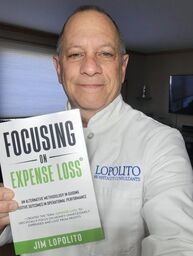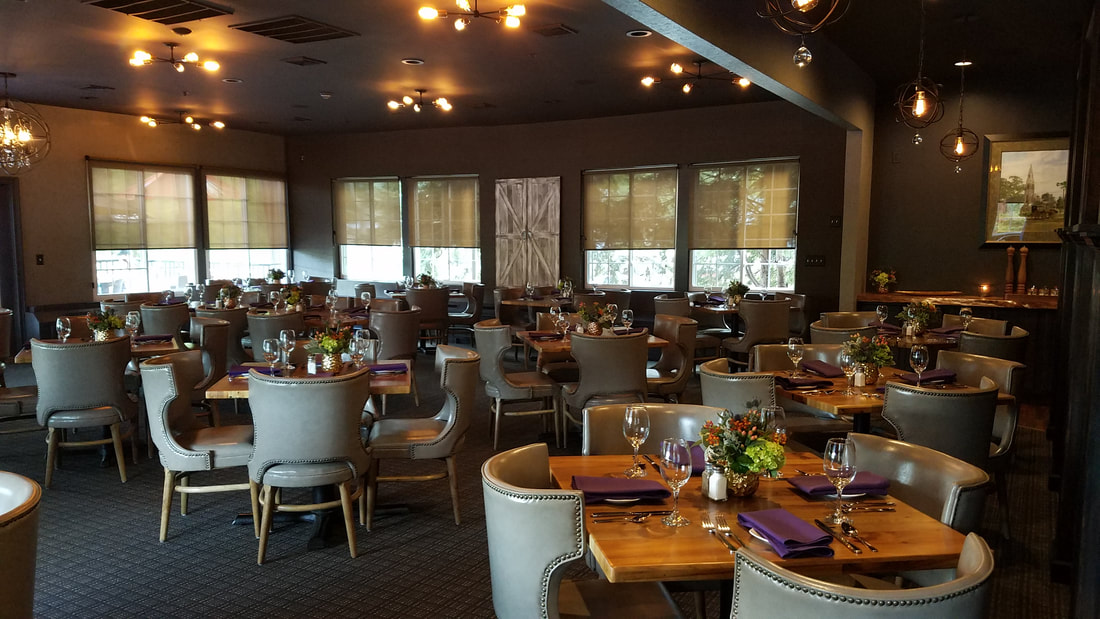My Life in WordsLHC - THE STORIES OF HOSPITALITY
Jim Lopolito
Lopolito Hospitality Consultants, Corp. (LHC) is a New York based consulting firm that offers Recovery Facilitation, Startup Development, Feasibility Studies, and Forward-Thinking Solutions alongside Operational and Management Practices to businesses in the hospitality industry. Jim Lopolito, President of Lopolito Hospitality Consultants, Corp. is a veteran of the restaurant, country club, catering & concert industries offering expert assistance with club management consulting, restaurant consulting, and other foodservice development. He has worked as an executive chef and general manager and has performed in a consulting role for more than 20 years. His proprietary “Expense Loss Review” program has been a highly sought after resource for his broad client base. |
|
An in-depth look into what you cannot control and what you should control. In this material, I embrace diverse methodologies in expense behaviors. The proficiency required to understand and control expenses is not as simple as it may seem. Revenue and expense, purchasing and inventory management, profit and loss, and many other factors are all tied together with an enduring management oversight behavior supported by knowledge and understanding of the industry. Becoming stagnant or comfortable in this arena is a dangerous cloud to hang over you. The likelihood, however, is that you do not have control over your expenses. Not really anyway. To help your restaurant management team cope with this challenge, what follows may offer a better understanding of exactly what this means with an encouraging ability to improve. Consider this methodology: "You need to know where your numbers are going before you get there."We all know that the controlling of restaurant expenses is a mix of; observing daily activities, market price research, purchasing effectiveness, having cost control procedures in place, effective use of restaurant POS system reports, and many other factors. However, at the heart of this understanding is a misunderstood and almost impossible ability to achieve the goal of full control. You may not have a full understanding of controlling expenses without the consideration and inclusion of what is not in your control. Here is a menu pricing control consideration: One effective method in controlling fluctuation in market costs would be to adjust each effected recipe cost and corresponding menu price as they occur accordingly. While this solution offers balance on profit concerns, imagine the work involved or how your customers would feel if you changed menu prices every time your costs changed. However, even if you actually performed this function, this attempt is skewed and diluted because your menu sales mix changes each day. Control Over Expenses Is A Perceived Outcome The control of restaurant expenses is a delusional byproduct of the sanities of management in their perceived ability to perform this function.What this means is relatively straightforward. If you believe you have a handle on your restaurant expenses, you may actually not. In understanding expenses, you must determine or realize what you cannot control, and then do your best with processes and procedures toward what you do have control over. This is important because there are expenses in the business that are a byproduct of operations that are out of your control, and if you are not aware of how this impacts upon your business, you may be misinterpreting your reporting. For instance, your menu is a fixed piece of business material as it does not generally change every day. You purchase a fish on your menu for $5 a pound today and the initial set menu price is $15, or 33% food cost based on only these two factors. Tomorrow the same fish cost you $6 a pound at a 40% food cost, but you do not change your menu price so you are losing 7% for each sale in this transaction because the original pricing for the menu was based on the $5 per pound. Do you monitor these occurrences and account for this loss in your reports? Most likely you do not. You might just follow a pattern that often occurs in the industry where you tell the chef that they have to do a better job in lowering the food cost. Oftentimes, this is difficult because the chef is ordering what is on the menu, and does not control market prices. Here are five examples where you do not have full control of expenses. The Concern · Daily Vendor Pricing Fluctuations: The pricing and product quality and quantities from vendors change regularly. Control over these fluctuations may include how much you order and from which vendor, but if you must purchase the product because it is on your menu, you do not have much choice over the price. However, in addition to the selection of the item and pricing there can also be a difference in quality or counts/weights on the items in the selection process, thus also affecting the finished product costs. The Fix · Daily Vendor Pricing Fluctuations: Track purchase price fluctuations on all products as a variance report. This can be performed daily or during inventory procedures, whereas, FIFO accounting can be used to offer a variance of amounts ordered against price differences during the month. The differences can be averaged, if necessary, in month to month price variations to assist with decisions and adjust recipe costs and menu prices. The Concern · Daily Menu Mix: Even with suggestive selling, the overall selection process is by the guest. This selection in turn moves the outcome of your profit and loss for the day. The daily menu mix also affects other factors like usage and spoilage, so the ability to maintain some control is through effective ordering procedures, effective selling techniques, and effective preparation and menu product usage, however, to purchase and prepare the exact amount in controlling these factors is extremely difficult to manage. The Fix · Daily Menu Mix: Each day will offer a different revenue and profit outcome, and one reason for this is because you do not sell the same amounts of the same items every day. If you know the differences in profit from each item (known as contribution margin) you can track your efficiency and use this to train staff on selling the higher profit items. This is also very useful as part of menu engineering and the placement of items on the menu itself. The Concern · Daily Loss of Product: While everyone tries to control breakage, loss of product, drops on the floor, spoilage, theft, and other similar loss of product factors, the control of these costs is essentially fate. Security of product can assist with some of these values; however, the best you can do is to be careful and proactive in addressing these circumstances and to record their value on profits. The Fix · Daily Loss of Product: You must track breakage, loss of product, drops on the floor, spoilage, theft, and other similar loss. You may be surprised at how these add up to loss of profits, and you should document this information in your reports. The Concern · Daily Returns and Adjustments: The control on returns and adjustments is basically in the hands of your guests. You can do your best to put out a good product, but not everyone is going to like what you produce. There are many factors like; returns, misfires, unknown free meals provided by employees, or spillage, and these examples all have additional expenses and are not controlled by the business. Recoding them is your best defense on understanding how this is affecting profits. The Fix · Daily Returns and Adjustments: Each item on the menu should have a recipe and cost. End of day reports should include; voids, comps, discounts, refunds, and any other report that you use to offer additional expense for the day. Every item should have a cost factor attached to it and you should track the amount you lost in revenue as a result of the lost or free offered product. If you comp a drink with a cost of $2, you didn’t just lose the $2. You also lose the difference in revenue from the lost sale from what you comp. The Concern · Laws Affecting Costs: Businesses are unable to control the wage laws and this is just one area of government control where you have no control. Taxes, labor laws and other factors must all be considered. You can try everything in your power to reduce salaries and cut these costs, but in the end, you have to place the people in positions to get the job done, and pay the price dictated by government influence. The Fix · Laws Affecting Costs: No business can control the new wage laws and you can only do your best to adjust how you perform operational practices to achieve your best performance. You can only do your best to control costs that are within your ability, but in the end the total control you have is really out of your hands. Controlling The Expenses You Can Control Controlling expenses begins with having a practice in place to regulate the outcome of your processes. Proactive procedures help with outcomes ahead, whereas, reactive procedures leave you behind. Without effective procedures and monitoring your outcome becomes ambiguous. Without knowledge-based behavior that supports future business performance with positive influencing of your results, you are just reacting to daily activities. The practice of expense control falls under the methodology and implementation of an Expenditure Behavior Management “EBM” process to influence your progress and results. EBM is an awareness driven decision-making practice in controlling business expenditures with an understanding of how the decisions you make today affect current and future operations as a whole. EBM methodology uses a proactive approach to addressing expenses. Just because you pay attention to your expenses does not mean you are doing everything you can. Everyday decisions can generate a constant toward loss from procedures in the business that has become overlooked or have become common behavioral practices. For instance, the common practice in evaluating end-of-month reports with implementing next month's cost controls or spending adjustments are old school and an afterthought process. This method fails in having current cost controls considerations in place, therefore continuing to perform this monthly ritual will only result in forever gone profits, or an Expense Loss condition. Expense Loss is the variance between money that is currently unsystematically expensed on product, services, or equipment and the achievable amount of expense reduction that is possible or interpreted through a review and fiscally applied methods of spending behavior and forward-thinking decisions. Having the knowledge of the variance between amounts you are spending now and the amount you could reduce this by, or procedures implemented that affect a cost reduction if you implemented them differently, is paramount. The Cost Side and the Lost Side of Spending Behavior. There are two considerations when understanding expense behavior. These are the Cost Side and Lost Side to spending behavior: COST SIDE A common viewpoint by managers in the spending decision process is the “cost side spending behavior” mentality. The Cost Side Spending Behavior is: What will this cost me in making this decision? When observing expenditures the cost side viewpoint most often presents a one-time decision that did not include forward considerations or continuous monitoring practices and is counterproductive to an effective EBM process. You become complacent into the thought that you made the decision on an amount of money to spend that feels right. There is no need to revisit this, especially if you are comfortable with your decision and the same expense is expected to come up again. In these situations, you and your managers may no longer question the cost of the item or service provided by a vendor no matter how much further reduction may be available in the marketplace, (knowingly or unknowingly) or how much you may be losing in Expense Loss by following this cost side methodology. Everyone is on board with the cost from the vendor and no further determinations are necessary. This behavior may continue until revenue drops below costs and a red flag goes up. Cost side spending behavior is a reactive based behavior pattern. LOST SIDE In contrast there is the “lost side spending behavior.” The Lost Side Spending Behavior is: The specific amount determined or interpreted as overspent and gone from your profits signaling a proactive sequence the next time this expense occurs. The end determination is to evaluate what your additional profits can be when considering alternatives to your decisions, and is a segment in the Expense Loss and EBM methodology. The goal is to get you to look closely at the amounts lost from purchasing and procedural decisions and add them up. Look at your operations as a whole in service standards, cleanliness and appearance, purchases, receiving procedures, inventory management, or anything else your company deals with in its entirety. View how each decision you make in each of the categories of your business may be participating to generating profits, or not, and where the Expense Loss condition exists in each category. Looking at expenses with a lost side mentality keeps you informed and attentive to future decisions that will not follow the same outcome. Lost side spending behavior is a preemptive knowledge-based behavior pattern. Keep in mind that a procedural decision may include you having no procedure in place for a particular situation and how this lack of attention may be affecting expenses. Examples of Expense Loss · At the bar: Consider that a ¼ ounce over pour on one drink from a $30 bottle of alcohol is 22 cents each occurrence. Over an annual basis of 10,000 drinks poured with a ¼ ounce over pour creates a $2,200 loss. Now add in the 2500 ounces lost in this scenario that could have made 406 more drinks using a 1.5 ounce pour at $8 a drink, (406 x $8) or $3,248, and you have a total Expense Loss of $5,448 for the year. Using this example you can understand that understanding expenses at the bar is essential, but you also need to know Potential Pouring Costs PPC, Actual Pouring Costs APC, recipe creation and costing, and understand spillage, theft, and other occurrences at the bar. At the bar, you can make a table to compare your Bottle Cost with Price Per Ounce and Loss to better understand the situation. Here is an example diagram that does not account for loss of revenue that results from over-pouring, which is the additional thing to consider. · In the kitchen: Waste management, over prepping, and not accounting for yields are just a few of the costly expenses associated with BOH operations. There are purchasing procedures, receiving procedures, and inventory management that are different than FOH operations, and to misunderstand these procedures is extremely costly to a business. Many operations concentrate on FOH revenue and sales and neglect the effectiveness of proper procedures that can reduce costs and add significant profits in the process. · · Reporting: Another factor in expense is when a restaurant relies on food cost percentages as the determining factor of how well the chef is attending to expenses, whereas, this alone should not be relied upon. The gauge should be a combination of: 1) Food costs percentages. 2) Daily menu mix. 3) Contribution margin considerations. After you consider these factors collectively to associate the actual outcome of the day, share them with your team. Knowing contribution margins, for instance, tells you what to sell for the highest profit, and if service staff does not have this information, the chef cannot be fully to blame. The management of restaurant expenses is not an easy process to fully understand or control. The incorporation of so many factors contributes to your success or to your failure. There can be many reasons that contribute to poor results in a business and to fully understand expenses and how to control them as the leading contributor to restaurant success. Do your due diligence, and train your restaurant staff about restaurant expenses as much as possible. Having a grasp on expenses can add significantly to your profits, and the more likely that you will succeed. #restaurant #catering #countryclub #cafe #bar #consulting #menuengineering #costcontrols #stafftraining #employeemanuals #chef #executivechef #coach #restaurantcoach
1 Comment
|


